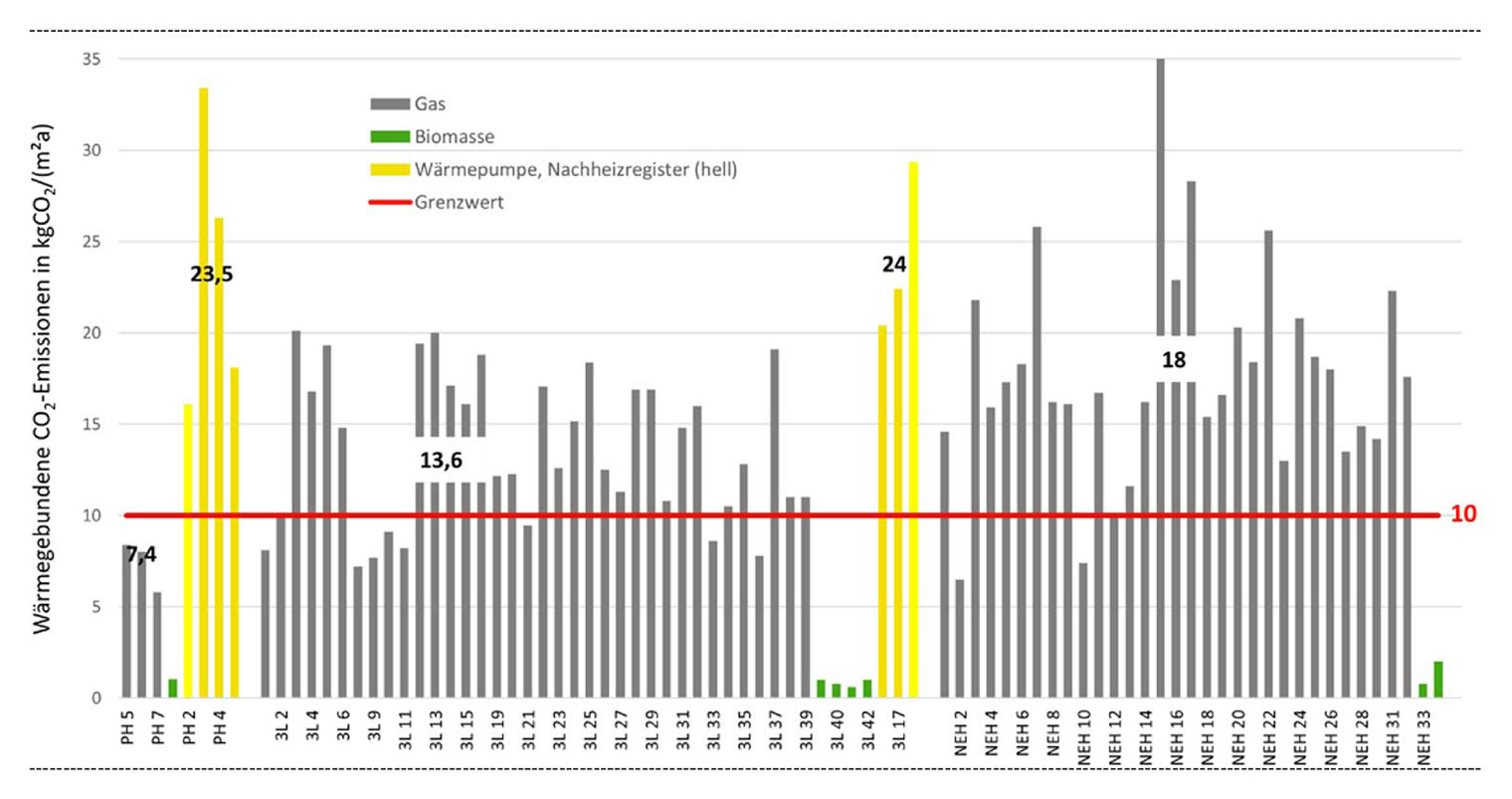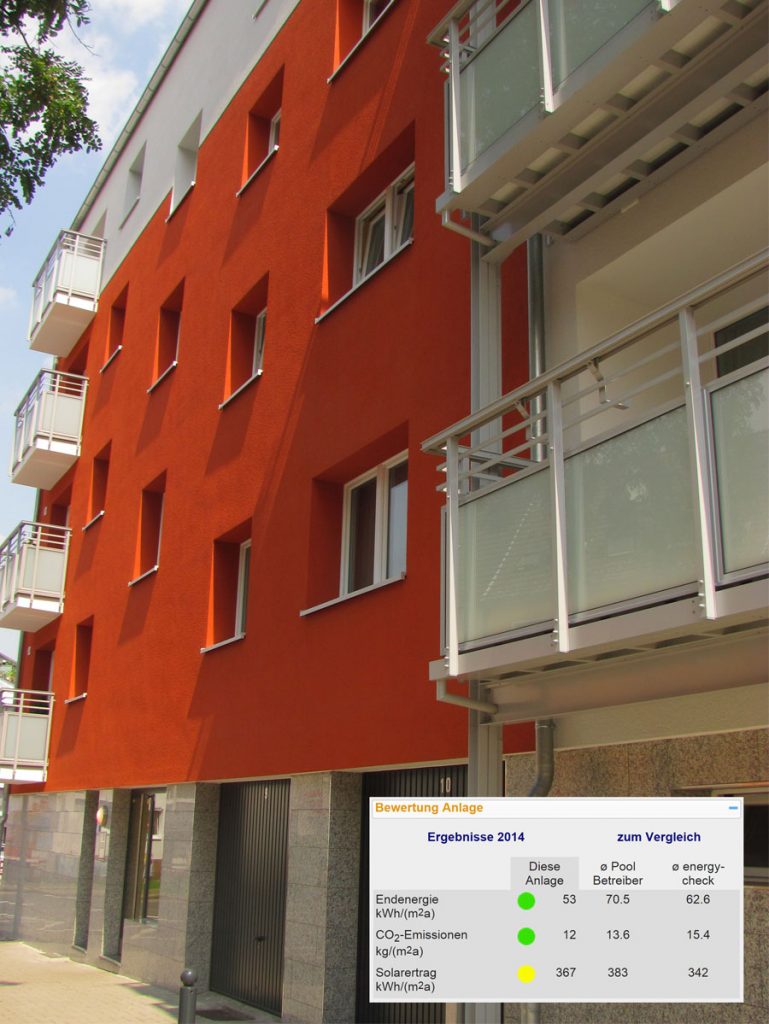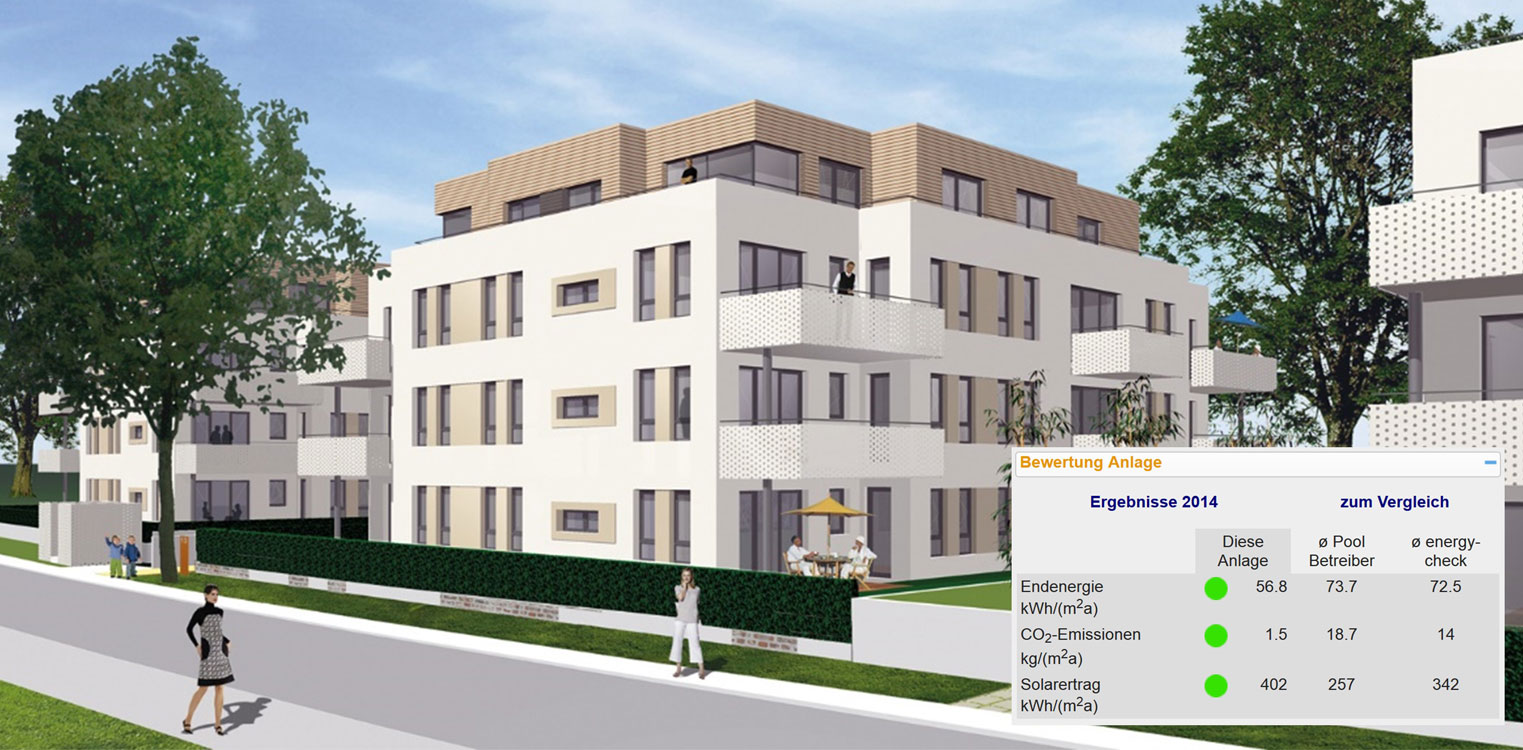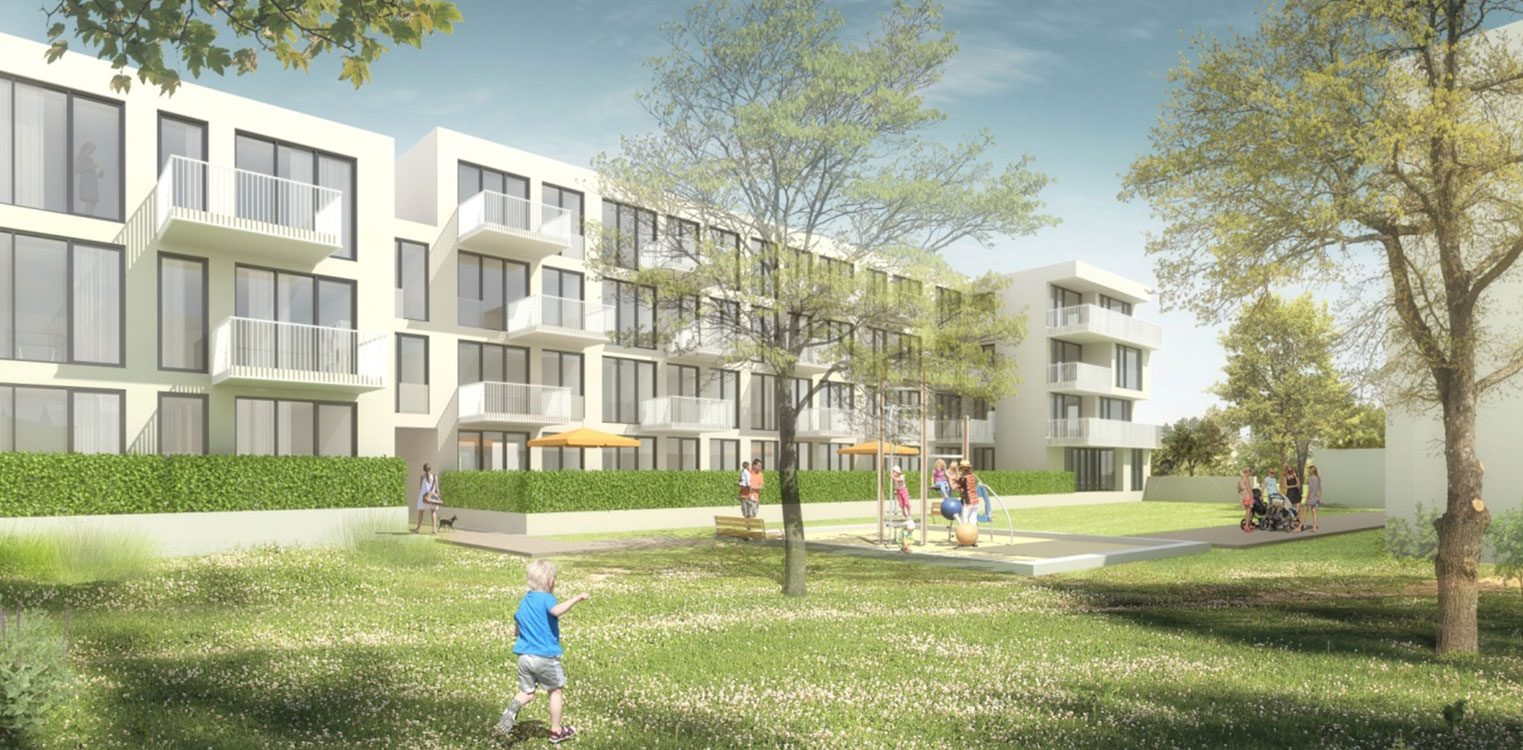Energy turnaround
Best solutions sought
The long-term project “Getting the energy turnaround right | Reference Controlling Buildings” will evaluate the operating results of 600 buildings. The aim is to accelerate the heat-energy turnaround in the building sector. For this purpose, 100 suitable buildings are still being sought.

Long-term experience: Heat-linked CO2 emissions in the operation of evaluated solar settlements.
The housing industry is looking for good energy concepts and often asks itself the question of the sensible level as well as suitable measures. Help is provided by looking at implemented positive examples of new construction and renovation and the knowledge that many ambitious measures achieve neither costs nor environmental goals. 80 single-family houses in NRW solar housing estates, for example, were designed to different thermal insulation standards with different systems for heat supply, with the majority of the buildings having solar heating systems. The long-term experience diagram shows the heat-related CO2 emissions in operation, which correlate with heating costs for gas (gray) and heat pump systems (yellow). Gas-fired passive houses (left) fall short of climate protection targets, while gas-fired 3-liter houses slightly exceed them (center). Buildings designed to the low-energy standard (right) and with heat pumps (yellow) show significant deviations in the monitoring. The gem. [1] are confirmed in their tendency by further independent recent investigations also for multi-family houses [2].
Transparent monitoring identifies robust systems and measures to efficiently reduce heating costs and environmental impact, and highlights unstable systems that have special requirements in terms of installation and operation.
EXAMPLE OF HIGHLY EFFICIENT EXPERIENCE-BASED REFURBISHMENTS
The refurbishment of 28 post-war apartments in Cologne-Mülheim can be taken as a positive example. These were renovated by means of comprehensive thermal insulation, an economical heating network and a solar system for hot water and heating. Through efficient use of funds of approx. 25,000 EUR per apartment, fuel costs were reduced from 14 to 3 EUR/m²a. Climate protection targets are almost met with 12 kgCO2/m²a (15 kg/m²a climate-adjusted). The refurbishment has been successful both in terms of efficient use of funds and in terms of low heating costs and emissions.
From the point of view of KfW funding, however, the refurbishment is only classified as a KfW Efficiency House 100. With the change in EnEV and KfW requirements from 2016, the aforementioned gas-solar solution for new buildings will even no longer be feasible, although cost and environmental targets are met in an exemplary manner with efficient use of funds.
WRONG INVESTMENT GUIDANCE BY ENEV AND KFW
Both the analysis of individual buildings and of housing stocks shows that heating costs and, at the same time, climate protection are often not related to the KfW and EnEV standards. Operating results of similar buildings from two stocks, each built to KfW 60/ KfW 70 standard, illustrate the differences: Buildings heated by heat pumps show fuel costs of approx. 10 EUR/m²a and CO2 emissions of approx. 30 kg/m²a. The primary energy equal but quality assured buildings from a gas-solar pool show fuel costs of about 5 EUR/m²a and CO2 emissions of about 20 kg/m²a.
The ordinances are influenced in part by the politically pushed electrification of the building stock. The essential primary energy factor of electricity, for example, was “arbitrarily” [3] reduced from 3.0 to 1.8 from 2006 to 2016. Heat pumps are declared the new control technology “with far-reaching consequences for competition” [4], although their practical operation shows a particular susceptibility to errors [5]. The theoretical calculation system of the EnEV is becoming increasingly distant from building practice. Necessary practical measures for quality assurance are not taken.
The KfW programs, which supported energy-efficient measures for around 2.4 million homes from 2006 to 2013, have a particularly effective steering effect. Despite the importance of the programs here, there is a lack of measurement-based feedback of the results obtained as a basis for decision-making for future construction and renovation projects [5]. The publication of results of energy-related construction and renovation measures is administratively difficult and can reveal errors that enable recourse claims. For heat pumps alone, the damage caused by excessive heating costs is estimated to be about 100 million EUR and 300,000 t CO2 already in 2011 [5]. The widespread adoption of resilient bottom-up approaches that are economically feasible today is not expected in public programs in the near term.

First existing building in the ReConGeb project: Successful energy refurbishment of Erbbauverein Köln eG
WITH THE CHANGE IN ENEV AND THE KFW REQUIREMENTS FROM 2016, SOME SOLUTIONS WILL NO LONGER BE FEASIBLE, EVEN THOUGH COST AND ENVIRONMENTAL TARGETS ARE MET IN AN EXEMPLARY MANNER WITH EFFICIENT USE OF RESOURCES.
ENERGY TRANSITION IS A PRACTICAL TASK FOR CIVIL SOCIETY
However, for a successful building energy transition, independent, long-term and transparent monitoring is necessary to enable building owners to make experience-based investments. The feedback and the comparison with target values enable a regulation of the heat-energy turnaround also in the economic sense. Policy makers and funding agencies can be provided with field-tested and economical methods to improve their instruments.
REALISTIC AND CONTROLLABLE GOALS NECESSARY
Instead of theoretical targets, understandable, realistically feasible and controllable targets are needed that enable cost efficiency and environmental compatibility. The target of heat-related service charges for heating and hot water with fuel and maintenance is, according to experience, about 3- 5 EUR/m²a. Benchmarks for maintenance are to be recorded separately. Environmental parameters are specified by the “2°C target” for maximum global warming [6] and are available in the state program “100 climate protection settlements NRW”: Experience has shown that compliance with the targets of 9 (new construction) or 12 (refurbishment) kgCO2/(m²a) is economically feasible.
COMPETITION FOR BEST SOLUTIONS

New construction project in the ReConGeb project: NRW climate protection housing estate of GEWOG Porz eG with biomass solar heating and operating results of the first construction phase
Based on the long-term evaluation of operating results, esp. The project “Doing the Energy Transition RIGHT I Reference Controlling Buildings” was developed to support the energy efficiency of housing facilities. Based on 600 buildings, a heat-energy turnaround in the building sector is to be demonstrated and accelerated in three stages over the 15-year term. Cost and environmentally friendly concepts compete in a transparent comparison: proven thermal protection concepts, solar and biomass systems, actually efficient electric heating systems, economical heat distribution and ventilation systems.
The overriding goal is to identify cost-effective and robust systems, but also to point out undesirable developments, e.g. if climate protection targets are not met or are only met at excessive cost. Independent empirical values thus serve as a basis for a genuine energy turnaround in the building sector. Special importance is attached to supporting professionals and planners in their work. The project is carried out with disclosure of financial resources from the manageable one-time contributions of the participating buildings.
Participating housing companies receive comprehensive information for their buildings:
- Assessment of the effectiveness of planned measures on building envelope, ventilation, heat distribution and heat generation
- Review of KfW documents with suitability test
- Information on quality assurance and warranty contracts
- Information on measuring points in the form of standard measuring schemes for planning support
- Monthly monitoring of key efficiency parameters, notification of limit value violations
- Annual reports on emissions and heating costs with comparison to similar buildings
- Information on the effectiveness of investments based on heat-related ancillary and maintenance costs and environmental impact
- Ability to view building performance online

New building project in the project: NRW-Klimaschutzsiedlung der GWG Schwerte eG with biomass solar heating and thermal insulation with passive house components
NEEDS CA. 100 SUITABLE RESIDENTIAL BUILDINGS WANTED FOR PROJECT LAUNCH
The feasibility of the project was coordinated in advance with leading experts in energy-efficient construction and renovation: Dr. Ernst Fleischhacker (Energy Monitoring Tyrol), Dipl.-Ing. Andreas Gries (thematic area manager for energy-efficient building and renovation at the NRW Energy Agency), Dipl.-Psych. Olaf Hofmann (SKOPOS Institute for Market and Communication Research), Dr. Ulrich Leibfried (Consolar Solare Energiesysteme), Prof. Dr. Madjid Madjidi (Munich University of Applied Sciences), Dipl.-Ing. Peter Zeiler (Peter Zeiler + Partner Ingenieurgesellschaft). The Ludwig-Bölkow-Foundation supports the dissemination and exercises a control function. The Energy Efficiency Foundation manages the project on a voluntary basis.
The first residential buildings have been contributed by Erbbauverein Köln eG, GEWOG Porz eG, GGH Heidelberg mbH and GWG Schwerte eG.
Approximately 100 suitable residential buildings are still being sought for the first stage of the project by Oct. 31, 2015. Building applications to the Energy Efficiency Foundation will be reviewed for eligibility by the end of 2015. Information about the project can be found at www.stiftung-energieeffizienz.org.
Sources
[1] Schreckenberg, D.: Langzeiterfahrungen mit Wärmeversorgungssystemen in Solarsiedlungen. Presentation at the network meeting on energy-efficient and solar construction on the topic “50 Solar Housing Estates in NRW – Exchange of Experience” of the EnergyAgency.NRW, Düsseldorf, 10.06. 2015.
[2] Ortjohann, J., Schreckenberg, D., Wenzel, W.: Report on the 2009-2011 beta test – Influence of quality assurance on the operating results of energy systems in the housing industry. Cologne, 2012
[3] Statement of the Federal Chamber of Engineers on the amendment of the Energy Conservation Act (EnEG) and the Energy Conservation Ordinance (EnEV) – Status: 15.10.2012. Berlin, 2012
[4] EnEV amendment: criticism from the associations. TGA Fachplaner-News 19.11.2012, retrieved from www.tga-fachplaner.de on 31.07.2015
[5] Ortjohann, J., Schreckenberg, D.: Energiewende RICHTIG machen I Referenz-Controlling-Gebäude. Working paper on the project, Cologne, 2015.
[6] Ortjohann, J.: Klimaschutz-Zielwerte zur Steuerung der Energiewende im Gebäudesektor. Presentation at the Information Circle Meeting “Energy Efficiency Monitoring of Existing Buildings” of the Institute Living and Environment, Darmstadt, July 8, 2015.
Energy Efficiency Foundation
Contact
Folding stick belt 5
D-50969 Cologne
T: 0221 546 57-05
F: 0221 54 28 27
www.stiftung-energieeffizienz.org
info@stiftung-energieeffizienz.org
Donations
Savings Bank Gütersloh
Donation account 505
BLZ 478 500 65
The purpose of the foundation is to promote environmental protection, education and consumer protection by ensuring and increasing the quality of energy efficiency, particularly of buildings and facilities, with the aim of achieving a full supply of renewable energy in the near future. It must be ensured that all information and data are used independently and free of commercial influence.
Recognized by the Detmold district government as a charitable foundation under civil law.
Tax number 351/5912/1004.
Management Board: Dipl.-Ing. Jörg Ortjohann
Board of Trustees: Dipl.-Psych. Olaf Hofmann, Dipl.-Kfm. Gert Wieland
Link to the online database of the Energy Efficiency Foundation:
www.energy-check.de

